Attracting hummingbirds to your yard is wonderful experience, and one of the most effective ways to accomplish the feat is by serving up a delicious nectar they simply can’t turn down. In today’s post, I’d like to present you with the 10 best hummingbird nectar recipes for a variety of situations as well as debunk a few misconceptions when it comes to feeding these charming winged creatures. By the end of this article, you’ll know for sure how to treat your garden to their enriching ways and create a safe, healthy snack for your flock.
Why Hummingbird-Safe Nectar Matters
Hummingbirds have very particular nutritional requirements. The wrong nectar recipe can discourage them from coming or (even worse) be bad for their health. Choose formulas with basic and natural ingredients that resemble nectar from flowers. There are no dyes, artificial sweeteners, or preservative-laden concentrates in any of the recipes listed here, and when it comes to feeding wild birds, thinking about health and safety is half the battle.
Essential Guidelines for Making Hummingbird Nectar
. Before we dig into recipes, there are some basic principles to keep in mind that apply across the board.
. Opt for clean, fresh water. If it’s safe for you to drink, tap water is fine.
. Skip food coloring. Hummingbird feeders themselves are typically red, and that’s all that’s required to draw them in.
. Clean feeders regularly. Unattended feeders can also develop mold or bacteria that pose a serious threat to birds.
. As we have gone through the entire run down, let’s move onto our top 10 recipes!
Classic Hummingbird Nectar Recipe
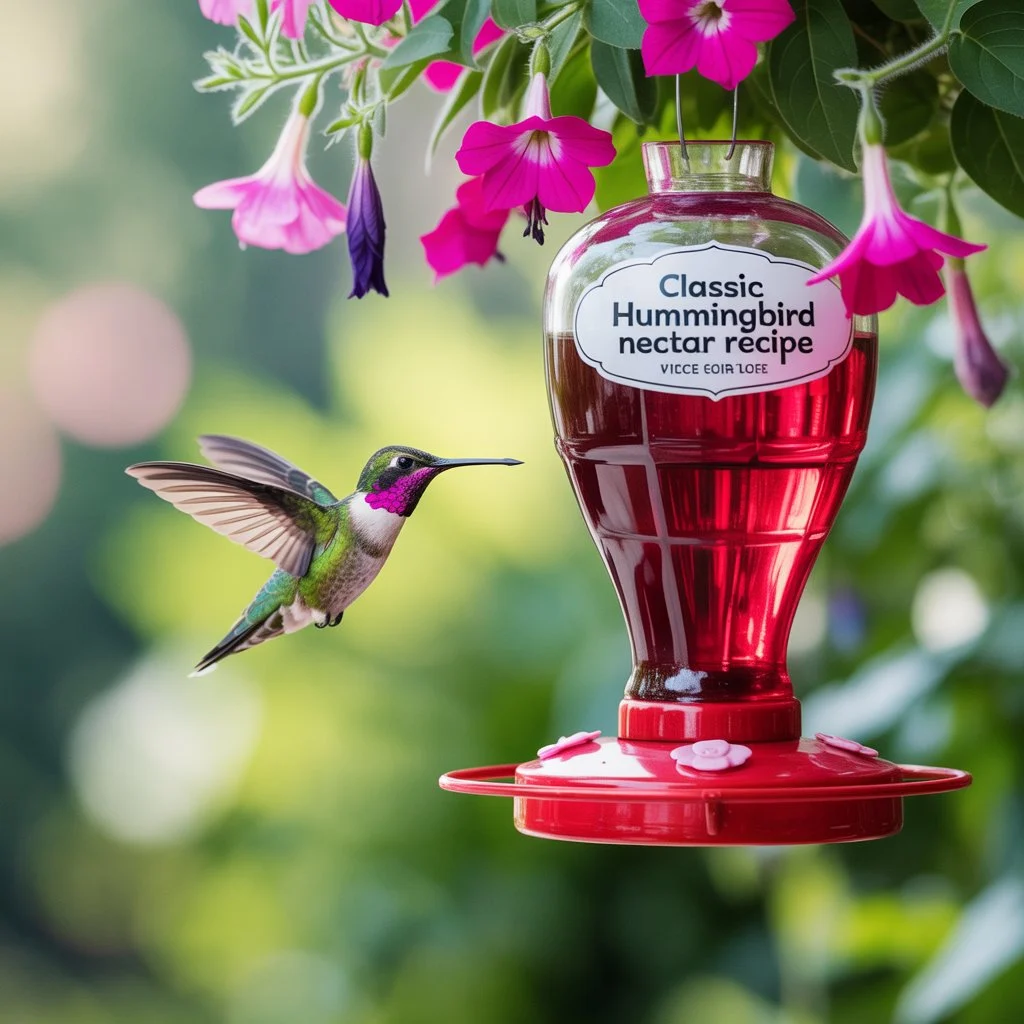
Classic Hummingbird Nectar Recipe
Simple, safe, and perfect for attracting hummingbirds to your feeder!
Ingredients:
- 1 part white granulated sugar (refined, no substitutes like honey, brown sugar, or artificial sweeteners)
- 4 parts water
Instructions:
- Boil Water: Bring the water to a rolling boil to remove impurities and help dissolve the sugar.
- Mix Sugar: Stir in the sugar until fully dissolved. No need to boil the mixture further once the sugar is dissolved.
- Cool Completely: Let the nectar cool to room temperature before filling your feeder.
- Fill & Hang: Pour into a clean feeder and place it in a shaded spot to slow fermentation.
Pro Tips:
- No Additives: Avoid red dye, food coloring, or flavorings—these can harm hummingbirds.
- Storage: Refrigerate unused nectar for up to 2 weeks.
- Freshness: Replace nectar every 2–3 days (daily in hot weather) to prevent mold or fermentation.
- Feeder Hygiene: Clean feeders thoroughly with hot water and vinegar (no soap) every time you refill.
Why This Recipe Works:
- Hummingbirds thrive on this 1:4 ratio, which mimics natural flower nectar.
- Avoid substitutes: Honey ferments quickly and promotes deadly fungus, while artificial sweeteners lack essential calories.
Happy birdwatching! 🌺
Always prioritize the health of these tiny pollinators by keeping feeders clean and nectar fresh.
Ultra-Light Nectar Recipe
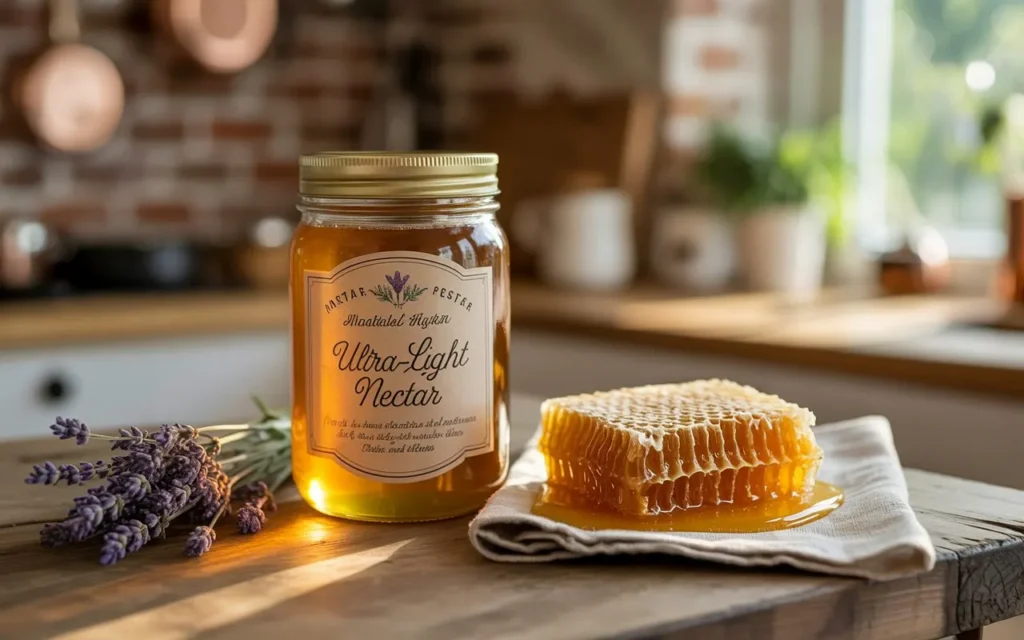
Important Reminder:
There is no safe “ultra-light” or diluted nectar recipe for hummingbirds. Their survival depends on a specific sugar concentration that matches the natural nectar they consume from flowers.
Why “Ultra-Light” Nectar Is Harmful:
- 🚫 Insufficient Calories: Hummingbirds require a 1:4 sugar-to-water ratio (25% sugar) to fuel their extreme metabolism. Diluting this ratio deprives them of critical energy.
- 🚫 Dehydration Risk: Weak nectar forces birds to drink more, disrupting their electrolyte balance and leading to fatal dehydration.
- 🚫 Toxic Substitutes: Honey, agave, or artificial sweeteners promote deadly mold, bacteria, or lack essential nutrients.
Only Safe Recipe:
- 1 part white granulated sugar
- 4 parts water
Instructions:
- Boil water to remove impurities.
- Dissolve sugar completely (no need to boil further).
- Cool and fill feeders.
If You Want to Reduce Insect Activity:
- Use bee guards or saucer-style feeders (no yellow parts).
- Place feeders in shaded areas and clean them every 2–3 days.
- Avoid drips and spills by filling feeders carefully.
Hummingbird health is non-negotiable.
Stick to the 1:4 ratio to keep these tiny wonders thriving! 🌺
Never compromise their survival for convenience.
Springtime Energy Boost Recipe
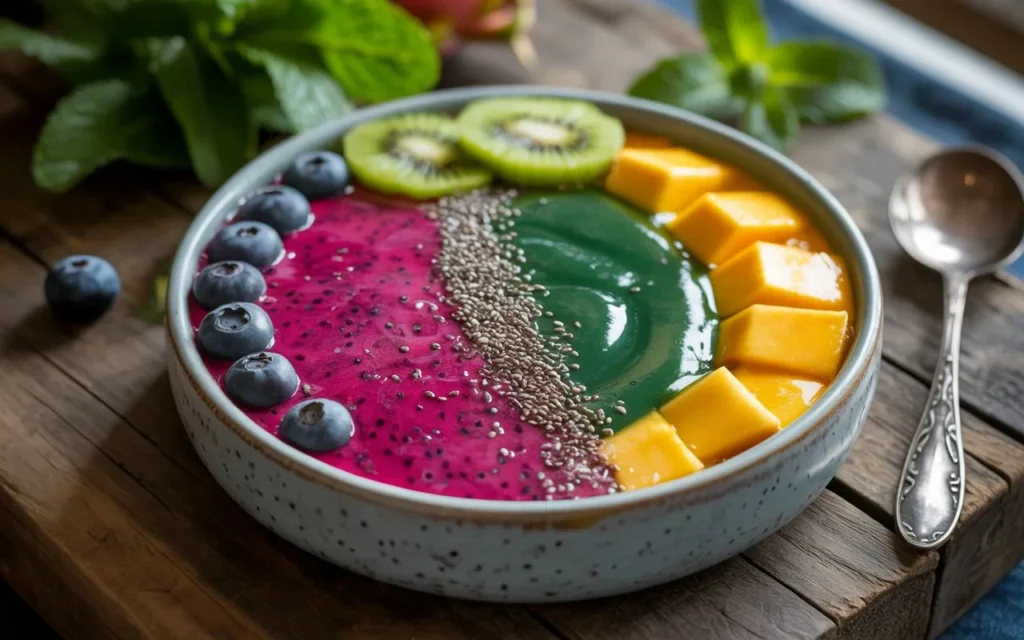
Springtime Energy Boost Smoothie Bowl 🌸💥
Packed with seasonal superfoods to combat fatigue and fuel your day!
Ingredients (Serves 1-2):
- 1 cup spinach or kale (iron + B vitamins)
- 1 frozen banana (natural sweetness + potassium)
- ½ cup frozen mango or pineapple (vitamin C + digestion aid)
- 1 tbsp almond butter or chia seeds (protein + healthy fats)
- ½ cup coconut water (electrolytes)
- ¼ tsp spirulina or matcha powder (optional, for a caffeine-free energy lift)
- Toppings: Fresh berries, bee pollen (immune support), granola, shredded coconut.
Instructions:
- Blend spinach, banana, mango, almond butter, and coconut water until creamy.
- Pour into a bowl and top with berries, bee pollen, and granola.
Why It Works:
- Leafy greens replenish iron stores (key for energy).
- Coconut water hydrates better than plain water.
- Bee pollen may reduce seasonal allergy symptoms.
Bonus Recipes for All-Day Energy:
1. Spring Green Juice
- Juice: 1 cucumber + 2 celery stalks + 1 green apple + ½ lemon (peeled) + 1-inch ginger.
- Benefits: Hydrating, anti-inflammatory, and rich in enzymes.
2. Lemon-Berry Chia Pudding
- Mix 3 tbsp chia seeds + 1 cup almond milk + 1 tsp vanilla + zest of 1 lemon. Refrigerate overnight. Top with fresh strawberries.
3. Herbal Energy Tea
- Steep 1 tsp dried nettle leaf + 1 tsp peppermint + 1 tsp lemon balm in hot water. Add raw honey to taste.
Spring Energy Tips:
- Get morning sunlight to reset your circadian rhythm.
- Snack on almonds or walnuts for sustained energy (no crashes!).
- Swap coffee for matcha or yerba mate for a gentler caffeine boost.
Embrace the season’s renewal! 🌱✨
Recipes are vegan, gluten-free, and refined sugar-free.
Calcium-Fortified Recipe
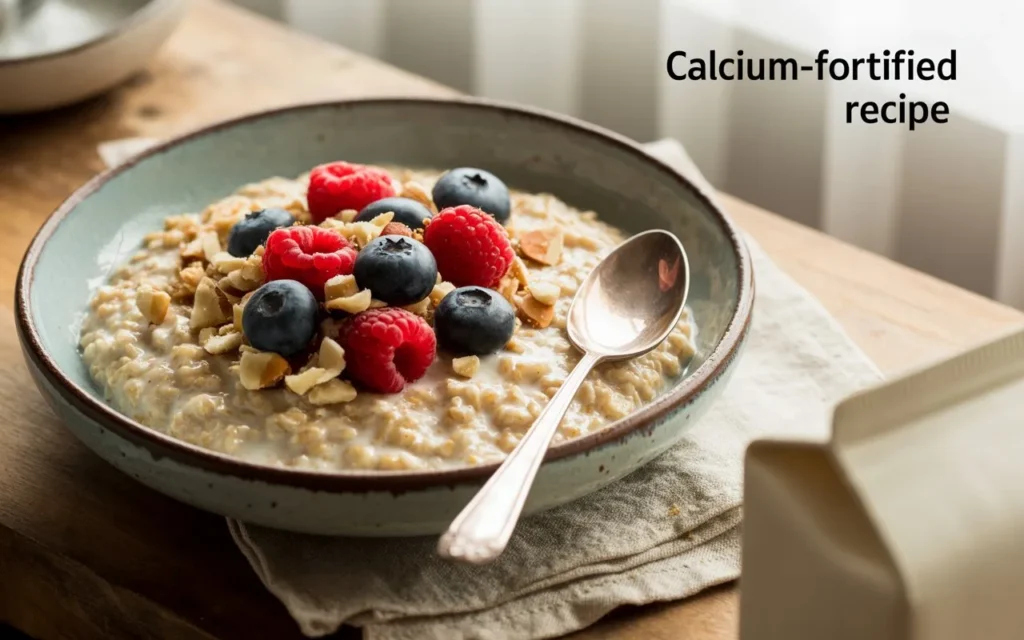
Calcium-Fortified Breakfast Smoothie Bowl
Packed with bone-strengthening ingredients to meet daily calcium needs! 🌱🦴
Ingredients (Serves 1):
- 1 cup calcium-fortified unsweetened almond milk (45% DV calcium per cup)
- ½ cup plain calcium-fortified Greek yogurt (20% DV) or dairy-free fortified yogurt (e.g., Silk or Alpro)
- ½ cup frozen spinach (12% DV calcium)
- ½ banana (for creaminess + potassium)
- 1 tbsp chia seeds (18% DV calcium)
- 1 tbsp almond butter (calcium-rich, but check label)
- ¼ tsp vanilla extract
- Toppings:
- Fortified granola (Look for 10-15% DV calcium per serving)
- Sliced figs (6% DV per fig)
- Blackstrap molasses drizzle (1 tsp = 5% DV calcium)
- Fresh kiwi or oranges (vitamin C for absorption)
Instructions:
- Blend almond milk, yogurt, spinach, banana, chia seeds, almond butter, and vanilla until smooth.
- Pour into a bowl and top with granola, figs, molasses, and fruit.
Calcium Breakdown (Per Serving):
- Almond milk: ~450 mg (45% DV)
- Yogurt: ~200 mg (20% DV)
- Spinach: ~120 mg (12% DV)
- Chia seeds: ~180 mg (18% DV)
- Molasses: ~50 mg (5% DV)
Total: ~1,000 mg (100% DV calcium*)
*Based on a 1,000 mg daily requirement for adults.
Dietary Adaptations:
- Vegan: Use fortified plant-based yogurt and skip honey (opt for maple syrup).
- Nut-Free: Swap almond butter for tahini (sesame seeds are calcium-rich).
- Lower Sugar: Skip molasses and use unsweetened yogurt + berries.
Why This Works:
- Fortified Foods: Non-dairy milks and yogurts are often enriched with calcium carbonate or tricalcium phosphate.
- Synergy: Vitamin C (kiwi/oranges) boosts calcium absorption.
- Natural Sources: Spinach, chia, and figs add magnesium and vitamin K for bone health.
Other Calcium-Rich Recipes:
- Tofu Scramble (calcium-set tofu + fortified plant milk + kale).
- Sardine Avocado Toast (canned sardines with bones = 35% DV calcium).
- Fortified Oatmeal (oats cooked in fortified milk + sesame seeds + dried apricots).
Note: Pair calcium-rich meals with vitamin D (sunlight, mushrooms, or supplements) for optimal absorption! ☀️
Wildflower-Infused Nectar Recipe
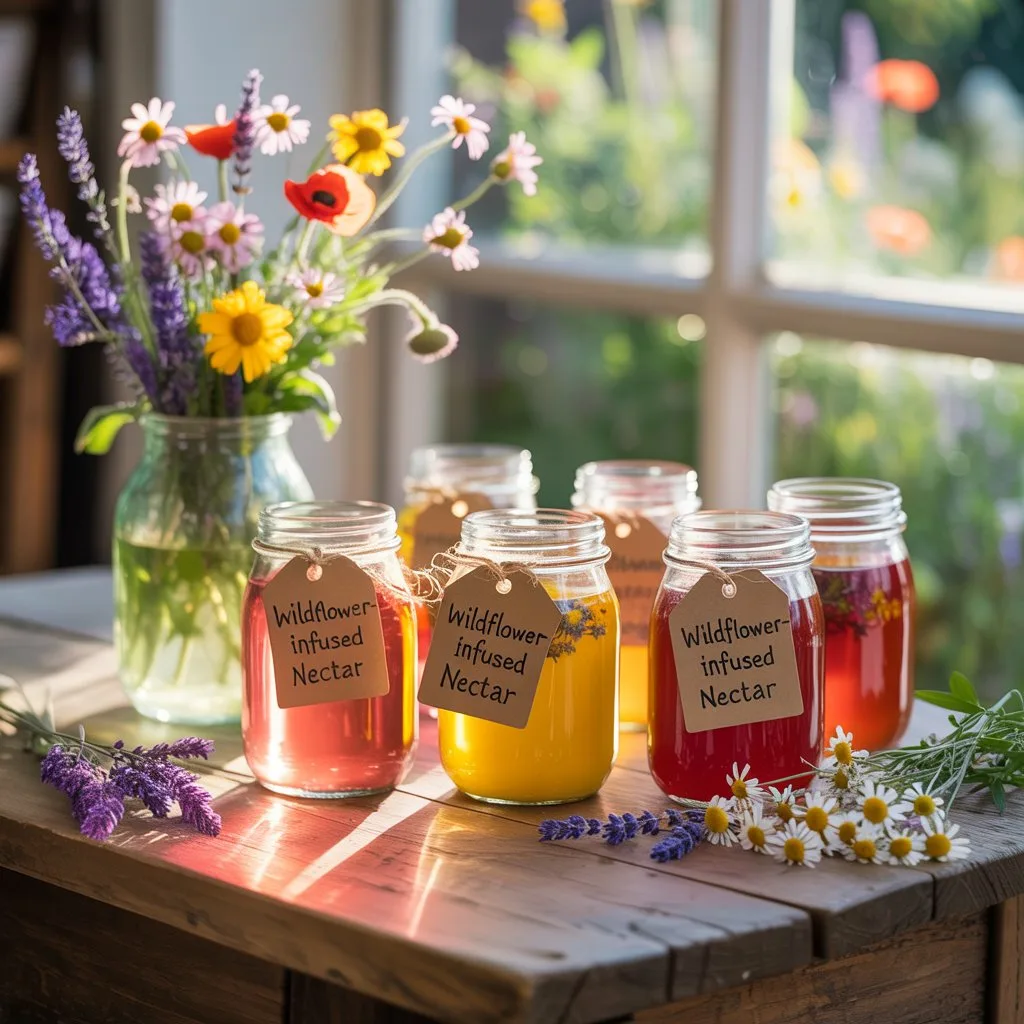
Wildflower-Infused Syrup (For Human Use)
Celebrate spring with a fragrant, floral syrup for drinks, desserts, or cocktails! 🌸🍯
Ingredients
- 2 cups fresh edible wildflowers (e.g., violets, elderflowers, dandelions, chamomile, or clover)
- 2 cups water
- 1 cup granulated sugar (or honey for a richer flavor)
- 1 lemon (juiced, for acidity and preservation)
Optional:
- 1 tsp culinary-grade rosewater or vanilla extract
- Pinch of citric acid (to extend shelf life)
Instructions
- Prep Flowers:
- Gently rinse flowers to remove dirt and insects. Remove stems/leaves (use petals only).
- Infuse:
- In a saucepan, combine water, sugar, and lemon juice. Bring to a simmer until sugar dissolves.
- Remove from heat, add flowers, and steep for 1–2 hours (cover with a lid).
- Strain:
- Pour through a fine mesh strainer or cheesecloth into a sterilized jar. Discard flowers.
- Store:
- Add citric acid (optional). Refrigerate for up to 2 weeks or freeze in ice cubes.
How to Use
- Drinks: Stir into sparkling water, lemonade, or cocktails.
- Desserts: Drizzle over pancakes, ice cream, or fruit salads.
- Gifts: Bottle in decorative jars with fresh flowers.
Important Notes
- For Pollinators (Hummingbirds/Butterflies/Bees):
- Do not add flowers, honey, or other ingredients to hummingbird feeders. Stick to the 1:4 sugar-water ratio (plain white sugar + water).
- Plant wildflowers like bee balm, lupine, or coneflowers to naturally attract pollinators to your garden.
- Safety:
- Only use edible, pesticide-free flowers. Avoid toxic varieties (e.g., foxglove, oleander).
- Avoid foraging near roadsides or sprayed areas.
Enjoy the taste of spring responsibly! 🌼✨
This recipe is for culinary creativity, not wildlife feeders.
Anti-Ant Nectar Solution Recipe
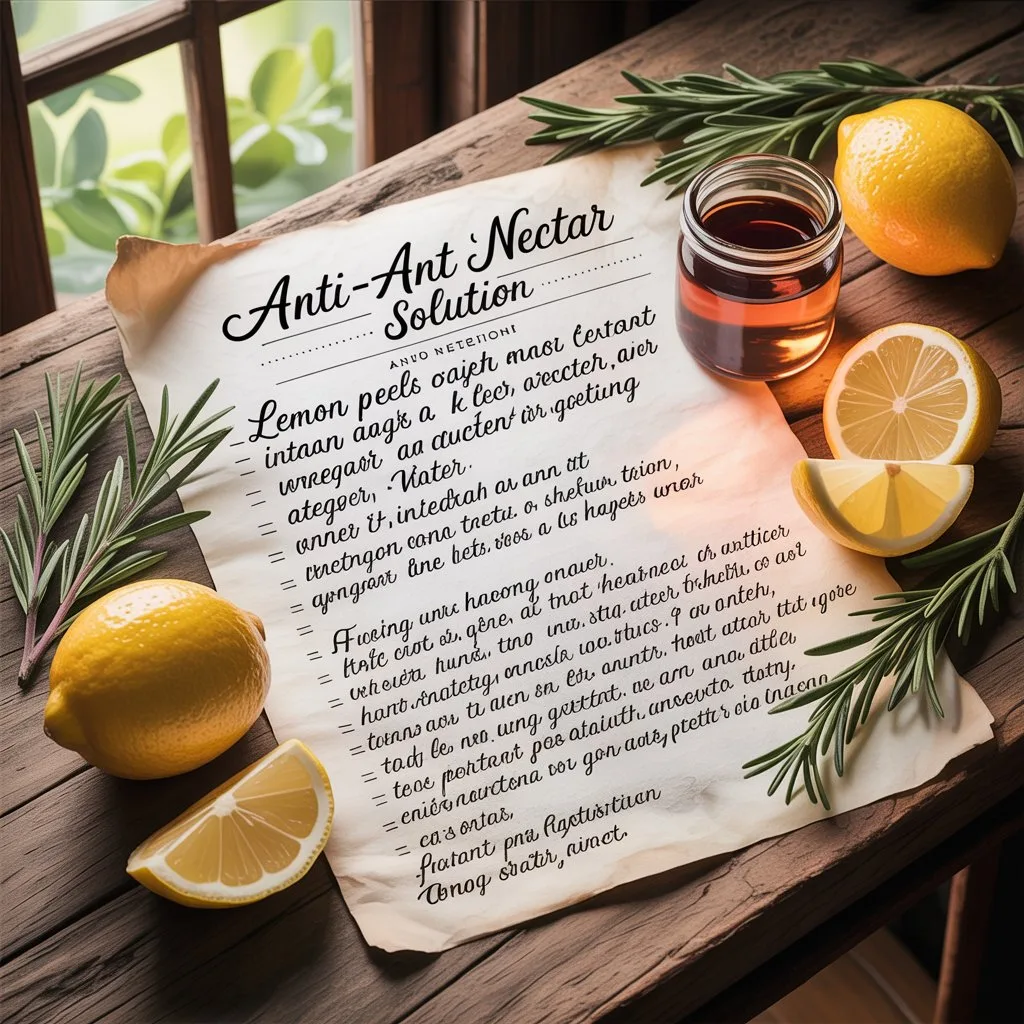
Safe Anti-Ant Solution for Hummingbird Feeders
Keep ants away without harming hummingbirds or the nectar! 🐜🚫
Why Ants Are a Problem
Ants are attracted to sugar water but can contaminate feeders, deterring hummingbirds. Never add pesticides, oils, vinegar, or spices to nectar—these can harm birds. Instead, use these humane, bird-safe strategies:
1. Use an Ant Moat
- What it is: A small cup filled with water, hung above the feeder. Ants can’t swim through it.
- DIY:
- Attach a plastic lid (e.g., yogurt container lid) upside-down above the feeder. Fill with water.
- Add 1–2 drops of dish soap to break surface tension and deter ants.
2. Apply a Physical Barrier
- Petroleum jelly or food-grade silicone grease: Smear a thin layer on the feeder’s hanging wire or hook.
- Double-sided tape: Wrap around the feeder pole.
3. Choose an Ant-Proof Feeder
- Opt for feeders with built-in ant guards or bee-proof designs (e.g., saucer-style feeders).
4. Keep the Area Clean
- Wipe spills: Clean feeder ports and the ground beneath regularly with a vinegar-water solution (1:1).
- Relocate feeders: Move the feeder every few days to disrupt ant trails.
5. Safe Nectar Recipe (Do Not Alter!)
- 1 part white granulated sugar
- 4 parts water
- Boil water, dissolve sugar, cool, and fill the feeder.
⚠️ Never add:
- Red dye, honey, artificial sweeteners, or spices (e.g., cinnamon, chili powder).
Natural Ant Deterrents (Around the Feeder, Not in Nectar)
- Sprinkle ground cinnamon or coffee grounds around the feeder base.
- Plant mint or tansy nearby (ants dislike these herbs).
Pro Tip: For persistent ants, combine a moat + barrier + feeder relocation. Stay consistent—ants are tenacious but manageable!
Hummingbird safety comes first! 🌺
Always prioritize the birds’ health while addressing ant issues.
Electrolyte-Replenishing Nectar Recipe
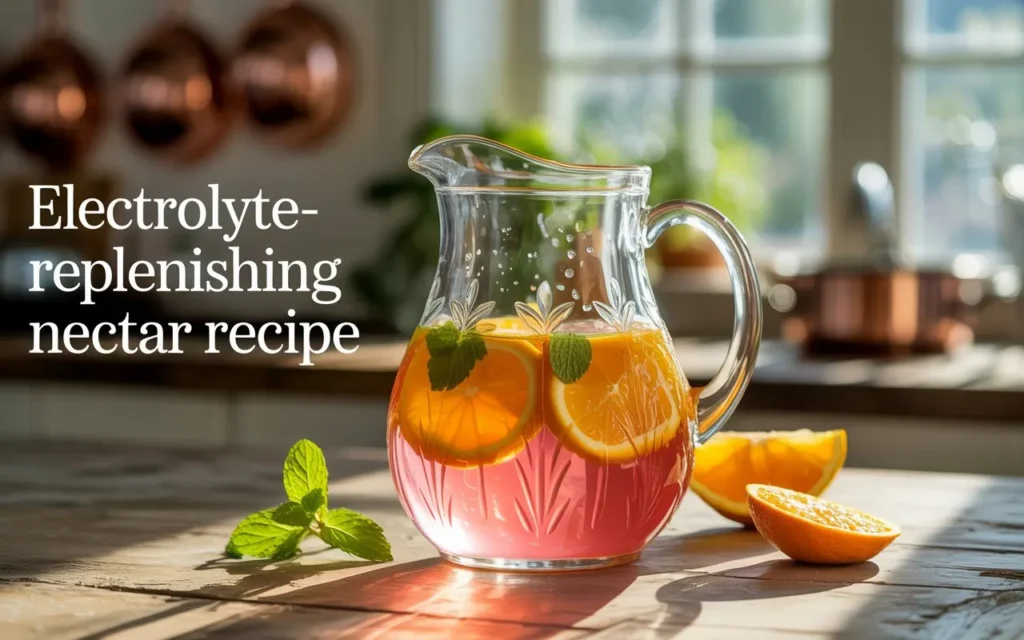
Important Note:
For Hummingbirds:
The only safe nectar recipe is 1 part white granulated sugar dissolved in 4 parts water. Adding electrolytes, salts, or other ingredients to hummingbird feeders can harm or kill them. Their tiny bodies cannot process additives, and electrolyte imbalances can be fatal.
For Humans: Homemade Electrolyte-Replenishing Drink
Perfect for post-workout, dehydration, or illness recovery! 💧🍋
Ingredients (Makes 1 liter):
- 4 cups water (filtered or coconut water for extra potassium)
- ⅓ cup fresh orange or lime juice (vitamin C + potassium)
- 2 tbsp raw honey or maple syrup (natural sugars for energy)
- ¼ tsp sea salt (sodium)
- ¼ tsp baking soda (sodium bicarbonate for pH balance)
- Optional:
- 1/8 tsp cream of tartar (potassium)
- 1 tbsp chia seeds (magnesium + fiber)
Instructions:
- Mix all ingredients until fully dissolved.
- Chill and sip throughout the day.
Electrolytes Provided:
- Sodium (salt + baking soda)
- Potassium (citrus juice, coconut water, cream of tartar)
- Magnesium (chia seeds or a pinch of magnesium powder).
When to Use:
- After intense exercise, heat exposure, or illness (e.g., flu).
- Avoid sugary sports drinks—this recipe is free of artificial dyes and additives!
For Hummingbirds:
Stick to the 1:4 sugar-water ratio and use an ant moat or bee guard to protect feeders. Never add salts, juices, or supplements.
Prioritize safety—what’s good for humans can be deadly for wildlife! 🌺
Label drinks clearly to avoid confusion with hummingbird nectar.
Flowery Protein Nectar Recipe
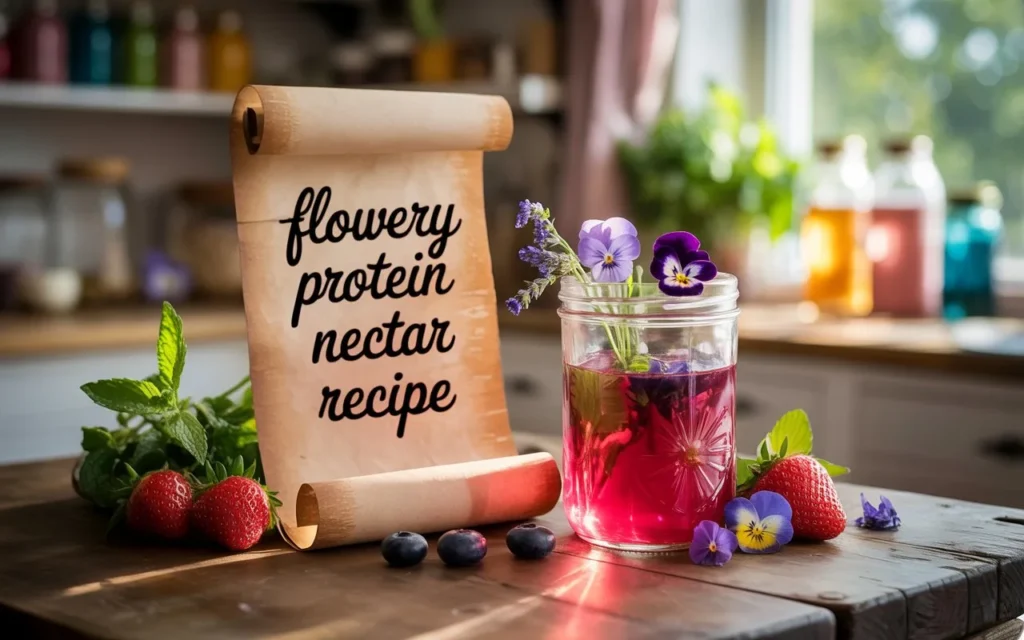
Important Note:
For Hummingbirds & Pollinators:
The only safe nectar for hummingbirds is 1 part white granulated sugar dissolved in 4 parts water. Adding protein, flowers, or other ingredients to feeders can harm or kill them. Hummingbirds get protein from insects, not nectar, and additives disrupt their delicate digestive systems.
For Humans: Flowery Protein Smoothie Bowl
A nourishing, floral-inspired recipe with plant-based protein and edible blooms! 🌸💪
Ingredients (Serves 1):
- 1 cup unsweetened almond milk (or coconut water)
- 1 scoop vanilla protein powder (plant-based, whey, or collagen)
- ½ cup frozen cauliflower (for creaminess + fiber)
- ½ frozen banana (natural sweetness)
- 1 tbsp edible flowers (e.g., lavender, rose petals, hibiscus, or violets) or 1 tsp culinary-grade rosewater
- 1 tbsp chia seeds (omega-3s + protein)
- Toppings:
- Fresh berries
- Bee pollen (optional, for immune support)
- Toasted coconut flakes
- Extra edible flowers for garnish
Instructions:
- Blend almond milk, protein powder, cauliflower, banana, chia seeds, and edible flowers/rosewater until smooth.
- Pour into a bowl and add toppings.
Dietary Adaptations:
- Vegan: Use plant-based protein (pea, hemp, or brown rice).
- Nut-Free: Swap almond milk for oat milk.
- Lower Sugar: Skip banana and use cauliflower + stevia/monk fruit.
Edible Flower Safety Tips:
- Only use pesticide-free, culinary-grade flowers (e.g., nasturtiums, calendula, borage).
- Avoid toxic varieties: Lilies, hydrangeas, daffodils, etc.
- Wash thoroughly: Rinse petals to remove dirt and insects.
Why This Works:
- Protein: Supports muscle repair and energy (20–25g per serving).
- Edible Flowers: Add antioxidants, vitamins, and aromatic flavor.
- Fiber: Chia and cauliflower aid digestion and keep you full.
For Pollinators:
- Plant protein-rich flowers like clover, sunflowers, or lupines to naturally support bees and butterflies.
- Keep feeders simple: Never add protein, honey, or flowers to hummingbird nectar.
Enjoy responsibly! 🌿✨
This recipe is for human use only—prioritize wildlife safety by keeping feeders unaltered.
Low-Sugar Winter Mix Recipe
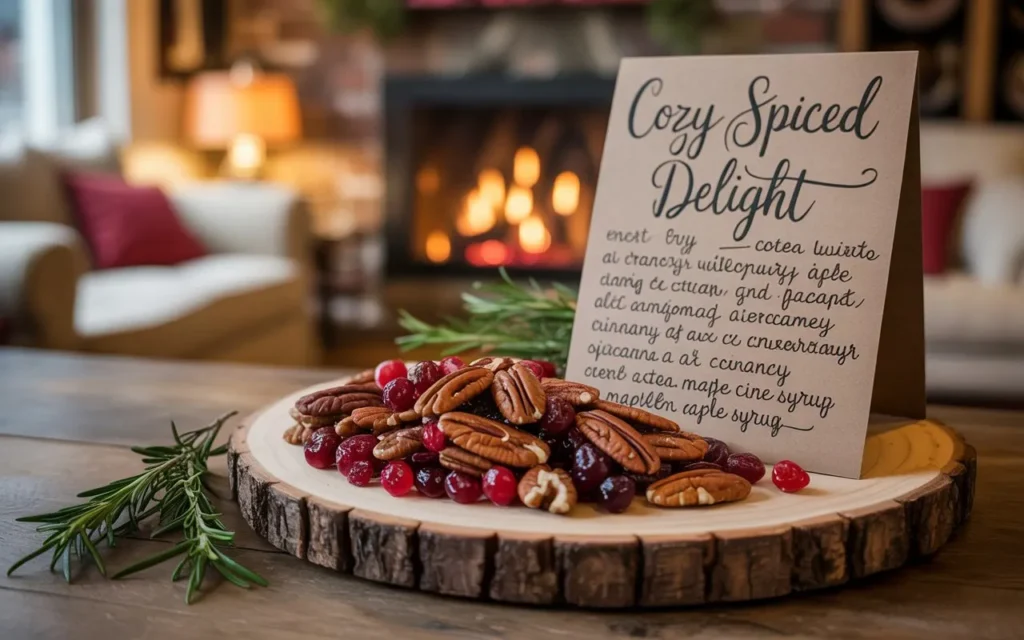
Low-Sugar Winter Mix Recipes
For cozy snacking or wildlife support—safely tailored to your needs! ❄️🌰
1. For Humans: Spiced Nut & Seed Winter Mix
A warming, low-sugar snack with protein and healthy fats.
Ingredients (Makes 4 cups):
- 1 cup raw almonds
- 1 cup raw walnuts or pecans
- ½ cup pumpkin seeds
- ½ cup sunflower seeds
- 1 tsp cinnamon
- ½ tsp ground ginger
- ¼ tsp nutmeg
- 1 tbsp coconut oil (melted)
- 1 tsp vanilla extract
- Pinch of sea salt
- Optional: ¼ cup unsweetened dried cranberries or coconut flakes (add after baking)
Instructions:
- Preheat oven to 325°F (160°C).
- Toss nuts and seeds with coconut oil, spices, vanilla, and salt.
- Spread on a parchment-lined baking sheet. Bake 15–20 mins, stirring halfway.
- Cool completely and mix with dried fruit (if using).
Why It Works:
- Low Sugar: Uses spices for flavor instead of added sugars.
- High Protein/Fiber: Keeps energy steady during shorter winter days.
Dietary Adaptations:
- Nut-Free: Use roasted chickpeas and seeds.
- Vegan: Ensure no honey-coated ingredients.
2. For Birds: Winter Hummingbird Nectar Reminder
In freezing climates, adjust temporarily (with caution!):
Standard Safe Recipe:
- 1 part white granulated sugar
- 4 parts water
(Boil, cool, and fill feeders. Clean every 2–3 days to prevent mold.)
Cold-Weather Adjustment (Only if nectar freezes):
- 1 part sugar
- 3 parts water
(Use sparingly and revert to 1:4 once temperatures rise. Never add red dye, honey, or antifreeze!)
Why This Matters:
- Hummingbirds need consistent calorie access in winter. A slightly stronger mix (1:3) delays freezing but must be temporary—overly concentrated nectar strains their kidneys.
Wildlife-Friendly Winter Tips:
- For Birds:
- Offer high-fat foods like suet cakes (for non-hummingbirds).
- Provide liquid water (use a heated birdbath).
- For Humans:
- Stay hydrated with herbal teas (cinnamon, ginger, or licorice root).
- Snack on roasted squash seeds or dark chocolate (85%+ cocoa).
Safety First:
- Never alter wildlife recipes beyond the 1:4 or 1:3 sugar-water ratios.
- For human mixes, avoid added sugars and prioritize whole ingredients.
Cozy and responsible winter fueling! 🐦✨
Label human/bird foods clearly to avoid mix-ups.
DIY Electrolyte and Calcium Combo Recipe
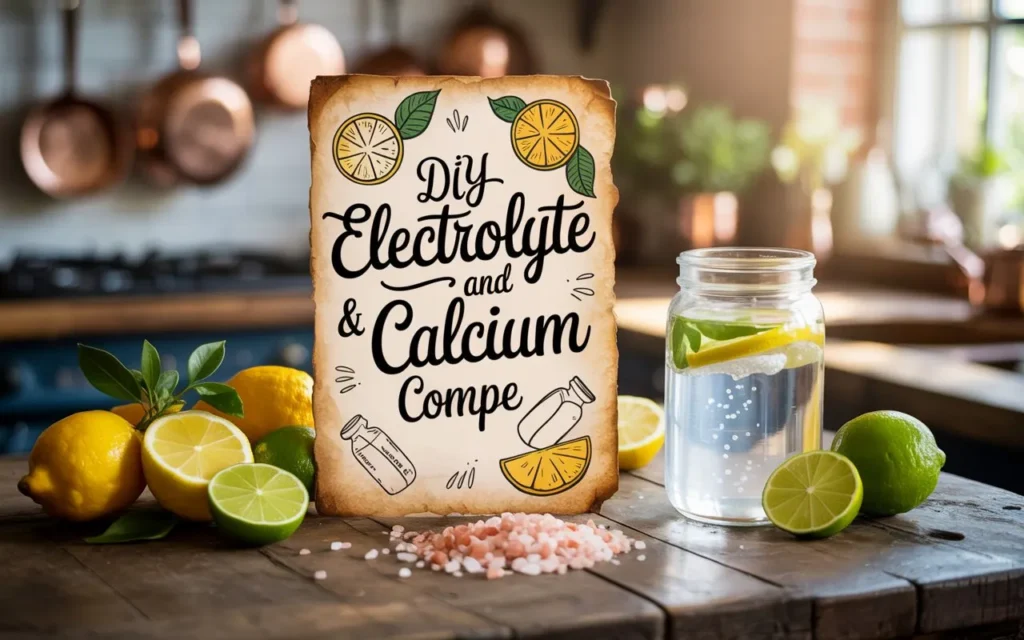
DIY Electrolyte & Calcium Combo Drink
A natural, nutrient-rich recipe to replenish minerals and support bone health—perfect for post-workout recovery, hydration, or daily wellness! 💧🦴
Ingredients (Serves 1–2)
- 1 cup coconut water (potassium, magnesium, sodium)
- ½ cup calcium-fortified orange juice (50% DV calcium + vitamin C for absorption)
- 1 tbsp blackstrap molasses (20% DV calcium + iron, magnesium)
- ¼ tsp sea salt (sodium + chloride)
- 1 tsp chia seeds (calcium + omega-3s)
- Optional:
- 1 tsp honey or maple syrup (for sweetness)
- ½ tsp vanilla extract (flavor boost)
- Pinch of turmeric or cinnamon (anti-inflammatory)
Instructions
- Mix: Combine all ingredients in a blender or shaker bottle until smooth.
- Serve: Pour over ice or enjoy at room temperature.
Why It Works
- Electrolytes:
- Potassium (coconut water) balances fluids and muscle function.
- Sodium (sea salt) prevents cramping and supports nerve health.
- Calcium:
- Fortified OJ + molasses provide 70% DV calcium per serving.
- Chia seeds add magnesium and fiber for bone strength.
Dietary Swaps
- Nut-Free: Use fortified oat milk instead of coconut water.
- Vegan: Skip honey; sweeten with dates or maple syrup.
- Lower Sugar: Omit molasses and use unsweetened OJ + a calcium supplement.
When to Use
- After intense exercise or sweating.
- During illness (e.g., dehydration, flu).
- As a daily calcium boost for bone density.
Pro Tips
- Boost Absorption: Pair with vitamin D (sunlight or mushrooms) for better calcium uptake.
- Prep Ahead: Make a batch and store in the fridge for 24 hours (shake before drinking).
Safety Notes:
- Not for wildlife (hummingbirds, etc.)—stick to sugar water for feeders.
- Consult a doctor if you have kidney issues or electrolyte imbalances.
Enjoy this refreshing, nutrient-packed drink to fuel your body naturally! 🌿✨
Common FAQs about Hummingbird Nectar
Absolutely! What doesn’t get used can be stored in the refrigerator for up to a week so you don’t waste any. Just be sure to return it to room temperature before serving.
Once a week at least in cold weather, 2-3 days at least in warm weather to avoid ferment and mould.
Haze is indication of impurity. Remove the feeder and empty it, completely clean it, and then re-fill with fresh nectar.
No, avoid red dyes. Most feeders are colored red which attracts hummingbirds naturally. Unnatural ingredients are bad for their health.
You may want to look at where your feeder is placed (it should be shaded), make sure the nectar is kept fresh and perhaps move the feeder closer to flowers or bushes from where the birds naturally feed.
Boost Your Backyard with These Recipes
Making the ideal nectar for hummingbirds is simpler than you might expect. Use these easy and safe recipes to turn your backyard into a hummingbird haven. Don’t forget, the key is to maintain your feeder and use the same ingredients to encourage these fluttering beauties to return.
Favorite recipe or nectar stories? Post them in the comments below, or link up with other bird lovers to swap ideas!
FAQ
During warm weather, you should change the sugar water every 2-3 days, while in cooler weather change it every 4-5 days, to keep the nectar from fermenting and developing mold, which can be harmful to the birds.
No, honey and other artificial sweeteners are NOT safe for hummingbirds. Then keep it simple, in a 1:4 ratio of white granulated sugar and water to keep them well.
No you do not need to add red dye. Many feeders are made with red that naturally attracts the birds, and dyes might cause them harm.
Position the feeder in a sheltered location (out of direct sunlight or strong wind). This helps the nectar to stay fresh for an extended period, and it also creates a safe and comfortable place for the birds to perch.
Opt for feeders with built-in ant moats and bee guards to help deter pests, while also allowing the hummingbirds to access the nectar easily.

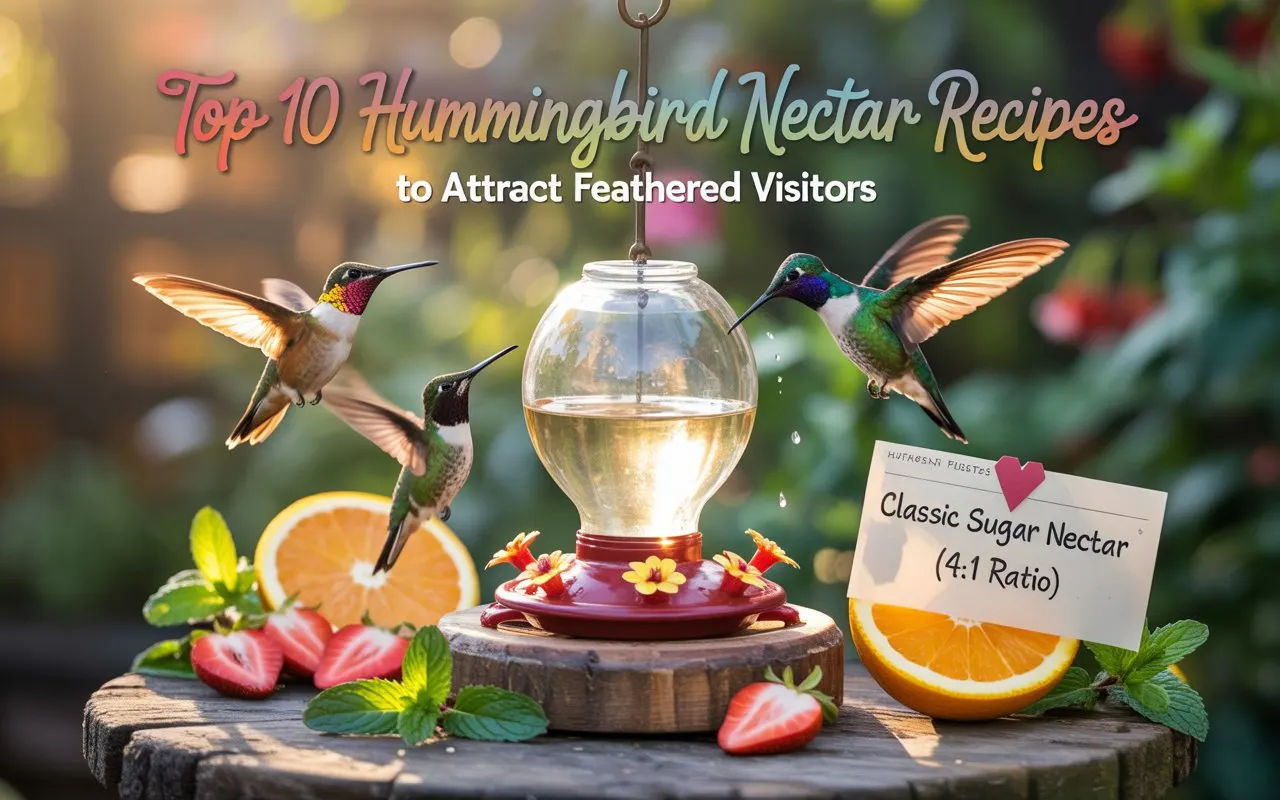
Leave a Reply